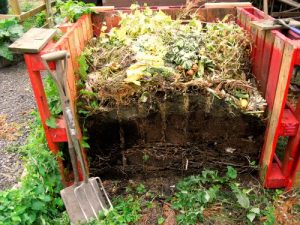The ins and outs of Composting!
Compost is decomposing carbon-based organic matter going through a series of complex chemical and biological processes. Carbon-rich organic matter interacts chemically with nitrogen in a moist, aerated environment and is further broken down with the help of biological agents like fungi, worms, bacteria and other micro-organisms. If we want to re-create the kind of soft, fertile soil we find under the leaf carpet of a forest rather than the gooey muck of a marsh, we need to think of a compost heap as a living thing that requires the essentials of all living things: air, food, and water in a balanced combination when maintaining a healthy compost pile.
Quality compost is a big part of healthy soils. Compost contributes to sufficient organic matter, and healthy bacteria. If your a home gardener, turning your compost will reduce the time it takes for the mixture to become usable.
If you have livestock, you need machinery to turn compost. Another option is having an area where chicken and pigs can mix compost by scratching for insects, foods scraps, and earthworms.
One recommended addition to your compost is Clay. It absorbs excess moisture and volatile gases, has a buffering effect for proper pH, and provides surface area and habitat for microbes. Clay will scavenge ammonia, accelerating the production of calcium humates, which are a prerequisite of a stable humus formation.
Another is adding Biochar, as it enhances the habitat for compost microbe populations.
Adding Gypsum and humates will cause a reaction between ammonia and sulfate creating ammonium sulfate, a stable form of nitrogen, available for plants.
When composting on large scale landscapes it is recommended to integrate cover cropping and tight rotations to achieve sheet composting.
Sheet composting is the practice of using plant residues or fresh vegetative portions of a crop and shallowly mixing them in your topsoil so they rapidly break down as a food source prior to planting a successive crop.
Mineralization is the process of liberating minerals from organic carbon compounds. Minerals are either complexed in stable humus (humified) or in a free form (mineralized).
Good compost requires a balance of mineralization and humification, which requires a buffet of feedstocks. Ultimately those raw materials have to be acted upon by microorganisms, especially fungi and actinomycetes.
Red-brown humic acids are more mobile, readily complex minerals.
If you have Comfrey growing around the garden. Add it to your compost or plot. It is a compost activator, with a massive tuberous root system, that can produce a great deal of biomass. Comfrey leaves are rich in nitrogen and carbon. They grow well on the perimeter of gardens, cropland, hedgerows, and trees.
Vigorous population of microbes in the rhizosphere translates into a balanced soil food web.
Fungal growth is important due to disease suppressive exudates produced by beneficial fungal organisms. These suppressive exudates are essentially antibiotics that eliminate harmful bacteria.
What is Compost Tea?
Compost is filled with beneficial microorganisms and nutrients, and you can take composting one step further by steeping it in aerated water. This process, extracts the microorganisms and soluble nutrients into a water “tea” solution. The goal of compost tea is to introduce nutrients, fungal colonies, and beneficial bacteria to either the soil or the foliage of your plants to aid in growth and provide protection from harmful disease.
What is Vermicompost?
This form of compost uses vermicastings (worm castings/poop) from native, or compost earthworms. The material has high nitrogen levels. If your looking to brew your own batch, put eight ounces of worm castings to one gallon of water, and soak for one to three days.
What is Nature farming?
Obtaining an inoculant from native soil in the forest or grassland and blending it with a substrate like wheat bran on molasses, and the subsequent culture is then inoculated upon rice in order to produce metabolites that can be used for plant growth, plant protection, odor control, and livestock health. It using a similar method as compost tea to inoculate soils with healthy bacteria and fungi.
